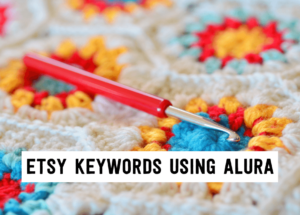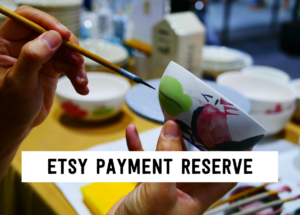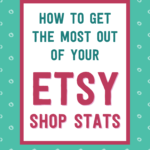
How to find the best Etsy keywords in 3 simple steps using Alura
If you want to be found in search results on Etsy, you need to optimize your product listing for SEO. And if you want to
join
join
When you have an Etsy shop, keeping an eye on your Etsy stats is really important to understand how things are going, what’s working, what’s not and how you can improve your results.
Inside your Etsy Shop Manager, Etsy gives you access to a dashboard called “Shop Stats” that will help you do just that.
Great! …
….Except… although the Shop Stats pages are easy to navigate and do give you a fair bit of data, it’s NOT always super easy to make sense of that data of what it all really means so you can actually DO something with it and improve your shop thanks to it.
It’s even possible that when you first take a deep dive into your Shop Stats you find yourself thinking “Holy cow Deb, what do all these numbers and graphs mean? What am I meant to do with this information?”
So in today’s video I’m going to walk you through these Etsy Shop Stats pages and explain what each term means, and how it can help you assess how your business and your listings are performing.
AND – just for fun – I’ve got a little quiz for you at the end so you can test yourself on your new Etsy Stats savvy!
So, ready? Let’s dive in.
So first off let’s have a look at your Shop Stats.
Inside your Shop Manager, if you look in the menu on the left you will find your “Shop Stats”. From there, you can select the timeline you want to take a look at up the top, and then the first four things that you will see are:
and if you click on each, you will see a graph that shows the data for that one.
So let’s go through and define each of these terms.
Visits is essentially how many people actually found your shop and visited your shop; so how many people looked at your shop or at your listing(s).
After visits is orders, which will be the total number of orders your shop has received – so not the number of items sold, but the number of orders received. For example, you might have sold 50 products, but only over 35 orders, because some orders were made of several products. This is just looking at how many orders you had, not products sold.
Next is conversion rate, which tells you what percentage of your shop visitors ended up ordering something— so it takes the number of orders you receive, and divides it by the number of visits.
This is a very important metric because it helps you understand if people who visit your shop end up wanting to purchase; if it’s low you know you need to look at your listings to see why they might not be purchasing and check things like pricing, titles, product descriptions, photos, and more. Your conversion rate is also important to signal to Etsy that “Hey, people are buying my products! You should show them more in Search” and a higher conversion rate can do wonders for your SEO strategy and to get shown even more on the search results page.
And finally you have revenue, which is the total amount of money you’ve collected from your sales after subtracting any postage or tax costs.
Now – before we dive deeper, I want to take a minute to cover something really important which is the BIG difference between views and visits.
I see a lot of Etsy sellers- especially when you first get started – that get these two terms confused, so I want to help clarify what each one means.
They are both important, they just tell you different things.

e-com sales on tap training
simple step-by-step plan to grow your online store sales into a consistent and predictable income with the Reliable eCom Sales System
Put simply, a visit means “a person”. One human being that came to your shop – so if you have 250 visits, you know that 250 different persons visited your shop over that time period.
Views are different. The number of views is more an indicator of if those visitors stayed in your shop and wanted to click on more listings, not just the one they initially came to see.
It’s an indicator of how many times your listings have been “seen”
So your views can tell you which ones of your products attract more “eyes,” . . .
. . . and it also tells you if someone who visits your shop stays to look at other products— for example if you have 5 visits, but 20 views, you know that on average every person has looked at four listings in your shop.
So having 20 views doesn’t mean that 20 different people have found and visited your shop, but that your listings have been seen 20 times, by one or multiple different people.
This difference is also important to understand when looking at your conversion rate. Your conversion rate is based on visits, not views.
Let me quickly explain why:
Let’s say you get a thousand views to your shop. Remember that a thousand views doesn’t necessarily mean a thousand different people (although that would be great, right?!). It’s more likely that maybe 500 or 600 people clicked around your shop, and each of those visitors clicked on multiple listings.
So if you use views to do your calculation, your conversion rate would be around 1%. But if you use visits – meaning actual visitors or unique visits -then your conversion rate will be around 3%.
I have a video about aaaaaalll about conversion rates where I explain this in more detail and teach you how to easily calculate your product conversion rates and make sense of them so make sure to check it out after you’re done with this article.
Now – because views and visits mean completely different things, you can actually use both of them in what’s called your “views to visits ratio” which is a really helpful piece of information, because it tells you on average how many listings people look at when they visit your shop.
For example, in our previous example 20 views / 5 visits = 4 ➡️ that’s how many listings on average people looked at in your shop.
OK – back to that Shop Stats dashboard.
The next thing you’ll find in your Shop Stats is How Shoppers Found You.
If you scroll down you will see that it’s divided into two sections:
Now as you hear about the different categories within each of these two sections, I know it can get a bit confusing and quirky and you might think some of the categories aren’t how you would logically classify the visits . . .
. . . and, to be honest, if you were to ask me if I thought it could be done better, I would probably say well yes I do haha! I do hope that eventually this article will be obsolete because they will have improved these categories— but at the moment, it’s just how it is … …So even though it may seem like an odd way to categorize the data in your shop, as long as you keep the definitions of these terms that we’re going to go through in mind, then when you look at your data you will know what this data actually means and you’ll be totally fine.
All right, now that we have that out of the way, let’s talk about the first column, the visits that Etsy helped you get.
The first category in this section is Etsy search, which tells you how many visitors found your shop after doing a search on Etsy.
Note: It’s important to know that this term doesn’t include people who found your shop when doing a search on the Etsy App, nor does it include people who clicked an ad that showed up in the results list of their Etsy search.
Instead, those are found in the next metric,
Etsy App and other Etsy pages. This includes visits from people who were browsing the Etsy App or browsing pages on Etsy.com
App pages include visits to your listings or shop from any page in the App, searching Etsy on the App, Etsy ads clicked on the app, etc.— so basically anyone finding their way to your shop or listings while using the App.
Etsy pages can include visitors that found you through category pages, editor’s picks, the Etsy community forums, and any other “internal” Etsy page..
Next, let’s talk about the Etsy Marketing and SEO metric.
This is essentially Etsy doing marketing FOR you outside of Etsy. So this can be traffic that you get from off-site Etsy ads on Google and Bing (so paid traffic from outside Etsy), OR from your listings being found on Google and Bing and other search engines organically (so organic search traffic from outside Etsy).
That wraps up the different categories in the “visitors that Etsy brought to your shop section,” so now let’s talk about the next section:
Visits that you bring yourself can happen in different ways.
The first is Direct & other traffic.
Direct traffic consists of visitors who typed your shop URL right into their browser, or who clicked a link that took them directly to your shop— perhaps in an email, an instant message, a blog, another website, etc.
Next is Etsy Ads, which consist of any visit you get from an ad that someone clicked on in the search results list in Etsy (so paid traffic ON Etsy).
It’s important to remember that this does not include visits from clicking on an Etsy ad in the Etsy App though (those clicks are recorded in the “Etsy app and other Etsy pages” section, or visits from clicking on offsite ads (which gets recorded under a different section we’ll get to in a second appropriately called “Offside Ads”).
Social Media is thankfully pretty straight forward. It includes visits where someone clicked a link to your shop from any social media website – Facebook, Instagram, Pinterest, etc.
Any click from social media counts here, whether it’s from your personal account, a link someone shared on social media, or a link from an offsite ad on social media.
So that covers the Shop Stats for visitors that come to your shop. Your head might be spinning a little bit at this point – I know… the categories are not super intuitive, it’s strange to have a category called “Etsy Marketing and SEO” that doesn’t actually include “Etsy SEO or Etsy search” as that’s what we’d naturally think of but once you get the hang of it it becomes second nature and you’ll just know where is what without having to think about it.
And actually – let’s do a fun little QUIZ together to test your knowledge (but also mostly because quizzes are fun and a GREAT way to learn and retain information).
I am going to ask 5 questions, try to guess the answer and let me know in the comments below how many you got right (no judgement, just for fun!)
#1 – If someone uses the Etsy App on say.. their phone .. searching for a keyword and finds one of your listings through that … where on the Etsy Stats page will it show up?
➡️ Etsy App and other Etsy pages
#2 – If someone clicks on one of your product listings from Google, after searching for a product there – where will this visit show up on the Etsy Stats page ?
➡️ Etsy marketing and SEO
#3 – If someone uses the website Etsy.com search field (you know the search bar at the top of the Etsy website) and finds your listing through that after searching for a few keywords, where will it show up on the Etsy Stats page ?
➡️ Etsy Search
#4 – If someone clicked on an Etsy promoted listing (so an Etsy ad) on the Etsy website to get to your listing, where will it show up on the Etsy Stats page ?
➡️ Etsy ads
#5 – And finally if someone clicks an Etsy ad while on the Etsy mobile app, where will it show up on the Etsy Stats page ?
➡️ Etsy App and other Etsy pages
Ok I am having a little too much fun with this so I’ll stop there because I want to share a few more things with you but let me know how many you got right in the comments below!
Let’s talk a bit about the next section on your dashboard, offsite ads.
Offside ads are pretty straightforward. We’re not going to dive too deep into this, but essentially these are ads on offsite web pages like Google, Etsy publishing partners, social media, etc. that Etsy runs for YOU and you only pay a fee if you make a sale from it. These “offsite ads” are required by Etsy (as in… you have to participate) if you made above $10.000 USD over the last year, or you can opt in on a voluntary basis if you haven’t reached that income level yet.
So if you do those ads you could click here to get a breakdown of the visits that came from those ads.
Now let’s move on to . . .
This section lets you compare stats of your product listings. You will see a list of all of your individual listings, and for each one it will tell you:
You can sort on each column and see which listings are performing best for each of the above categories – it’s a great way to compare your individual listings all in one place.
This gives you a nice overview of which listings are performing better in terms of views, revenue, etc. If/when you click on a listing it loads a more detailed stats page for that specific listing.
The first thing you will see on the product details page are visits, items sold, and revenue for this particular product – so far so good.
Down at the bottom you will see a section called Explore Your Data where you can explore all of your data by essentially combining any of these four metrics.
So, for example, you can compare
or any other combination you prefer.
When you do this, the graph above will have two curves, showing and comparing that data.
You can use this to figure things out like:
Sometimes you may see a big peak in views for a specific listing that didn’t necessarily convert to as many orders as you thought.
And that’s a good starting point to investigate the traffic quality. So why did you get a lot of views suddenly, but they didn’t convert? Is it because you changed keywords? And they were less targeted? Or Is it because you ran an ad campaign from, for example, Instagram, and it didn’t send the right type of customers to that listing, so that didn’t convert into a sale?
That is really valuable information.
Or . . . did the opposite happen? If your views are nicely correlated to your revenues and your orders, you can think about what you are doing at that point in time that’s working well so you know to do it again!
Scrolling down below the Explore Your Data section you will see Traffic sources. These categories are exactly like the ones on the shop overview page, but with numbers for that specific listing.
Next is search terms, which shows you what search terms this listing is being found for – which can be very helpful.
You can look here to determine:
So essentially this section gives you an idea of what search terms people are using to find your shop or listings so you know which ones to use more in the future.
Social media is exactly like the shop overview version, but for that specific listing, and gives you an overview for that listing of where people came from if they came from social media.
And finally we have favorites, which shows you how many people favorite this item over the time frame you have selected.
When you have a firm grip on what each shop stat category means, you are in a much better position to find the information you need, and use it to get more traffic and sales.
Now – if you want to see your Etsy shop stats and sales go up, you will want to read this article about 10 tips on how to make more sales on Etsy.
Thanks for reading, and until next time, au revoir!

free “Beyond etsy” training!
Discover how to make a full-time income and future-proof your business without spending every waking hour on social media, or having to rely on Etsy’s ever-changing platform.
you might also like…
related articles

If you want to be found in search results on Etsy, you need to optimize your product listing for SEO. And if you want to

There has been a lot of talk in the Etsy community — and I mean A LOT of talk — about Etsy’s payment account reserve

Anyone who knows me knows that I am a HUGE advocate for using email marketing to grow and scale your handmade business. But you may
disclaimer
subscribe to youtube
THE LAUNCHPAD
get in touch
We acknowledge and give thanks to the Budawang and Yuin people, the Traditional Owners of the land we work and live on. We pay our respects to all Aboriginal and Torres Strait Islander Peoples and elders past, present and emerging.



Learn how to grow your business beyond etsy as easily as possible

learn how to grow your online store sales into a consistent and predictable income